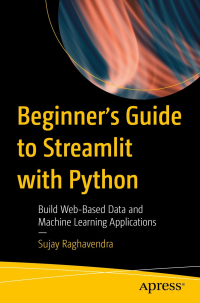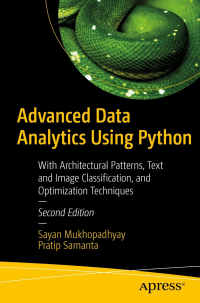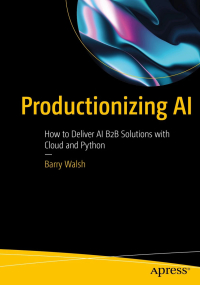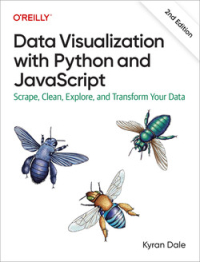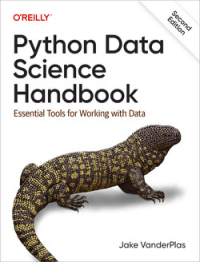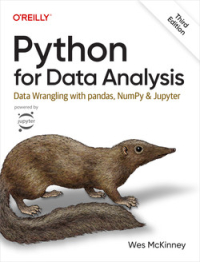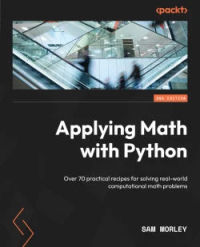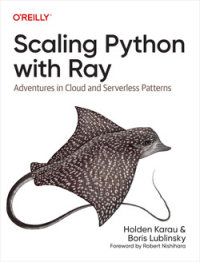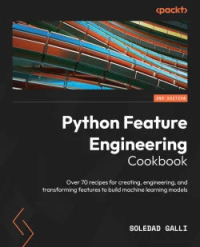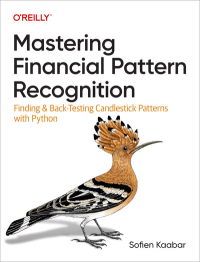Python eBooks
Beginner's Guide to Streamlit with Python
This book will teach you the basics of Streamlit, a Python-based application framework used to build interactive dashboards and machine learning web apps. Streamlit reduces development time for web-based application prototypes of data and machine learning models. As you'll see, Streamlit helps develop data-enhanced analytics, build dynamic user experiences, and showcases data for data science and machine learning models. Beginner's Guide to Streamlit with Python begins with the basics of Streamlit by demonstrating how to build a basic application and advances to visualization techniques and their features. Next, it covers the various aspects of a typical Streamlit web application, and explains how to manage flow control and status elements. You'll also explore performance optimization techniques necessary for data modules in a Streamlit application. Following this, you'll see how to deploy Streamlit applications on various platforms. The book concludes with a few prototype na ...
This book will teach you the basics of Streamlit, a Python-based application framework used to build interactive dashboards and machine learning web apps. Streamlit reduces development time for web-based application prototypes of data and machine learning models. As you'll see, Streamlit helps develop data-enhanced analytics, build dynamic user experiences, and showcases data for data science and machine learning models. Beginner's Guide to Streamlit with Python begins with the basics of Streamlit by demonstrating how to build a basic application and advances to visualization techniques and their features. Next, it covers the various aspects of a typical Streamlit web application, and explains how to manage flow control and status elements. You'll also explore performance optimization techniques necessary for data modules in a Streamlit application. Following this, you'll see how to deploy Streamlit applications on various platforms. The book concludes with a few prototype na ...
Advanced Data Analytics Using Python, 2nd Edition
Understand advanced data analytics concepts such as time series and principal component analysis with ETL, supervised learning, and PySpark using Python. This book covers architectural patterns in data analytics, text and image classification, optimization techniques, natural language processing, and computer vision in the cloud environment. Generic design patterns in Python programming is clearly explained, emphasizing architectural practices such as hot potato anti-patterns. You'll review recent advances in databases such as Neo4j, Elasticsearch, and MongoDB. You'll then study feature engineering in images and texts with implementing business logic and see how to build machine learning and deep learning models using transfer learning. Advanced Analytics with Python 2nd edition features a chapter on clustering with a neural network, regularization techniques, and algorithmic design patterns in data analytics with reinforcement learning. Finally, the recommender sy ...
Understand advanced data analytics concepts such as time series and principal component analysis with ETL, supervised learning, and PySpark using Python. This book covers architectural patterns in data analytics, text and image classification, optimization techniques, natural language processing, and computer vision in the cloud environment. Generic design patterns in Python programming is clearly explained, emphasizing architectural practices such as hot potato anti-patterns. You'll review recent advances in databases such as Neo4j, Elasticsearch, and MongoDB. You'll then study feature engineering in images and texts with implementing business logic and see how to build machine learning and deep learning models using transfer learning. Advanced Analytics with Python 2nd edition features a chapter on clustering with a neural network, regularization techniques, and algorithmic design patterns in data analytics with reinforcement learning. Finally, the recommender sy ...
Productionizing AI
This book is a guide to productionizing AI solutions using best-of-breed cloud services with workarounds to lower costs. Supplemented with step-by-step instructions covering data import through wrangling to partitioning and modeling through to inference and deployment, and augmented with plenty of Python code samples, the book has been written to accelerate the process of moving from script or notebook to app. From an initial look at the context and ecosystem of AI solutions today, the book drills down from high-level business needs into best practices, working with stakeholders, and agile team collaboration. From there you'll explore data pipeline orchestration, machine and deep learning, including working with and finding shortcuts using artificial neural networks such as AutoML and AutoAI. You'll also learn about the increasing use of NoLo UIs through AI application development, industry case studies, and finally a practical guide to deploying containerized AI solutions. ...
This book is a guide to productionizing AI solutions using best-of-breed cloud services with workarounds to lower costs. Supplemented with step-by-step instructions covering data import through wrangling to partitioning and modeling through to inference and deployment, and augmented with plenty of Python code samples, the book has been written to accelerate the process of moving from script or notebook to app. From an initial look at the context and ecosystem of AI solutions today, the book drills down from high-level business needs into best practices, working with stakeholders, and agile team collaboration. From there you'll explore data pipeline orchestration, machine and deep learning, including working with and finding shortcuts using artificial neural networks such as AutoML and AutoAI. You'll also learn about the increasing use of NoLo UIs through AI application development, industry case studies, and finally a practical guide to deploying containerized AI solutions. ...
Data Visualization with Python and JavaScript, 2nd Edition
How do you turn raw, unprocessed, or malformed data into dynamic, interactive web visualizations? In this practical book, author Kyran Dale shows data scientists and analysts-as well as Python and JavaScript developers-how to create the ideal toolchain for the job. By providing engaging examples and stressing hard-earned best practices, this guide teaches you how to leverage the power of best-of-breed Python and JavaScript libraries. Python provides accessible, powerful, and mature libraries for scraping, cleaning, and processing data. And while JavaScript is the best language when it comes to programming web visualizations, its data processing abilities can't compare with Python's. Together, these two languages are a perfect complement for creating a modern web-visualization toolchain. This book gets you started. ...
How do you turn raw, unprocessed, or malformed data into dynamic, interactive web visualizations? In this practical book, author Kyran Dale shows data scientists and analysts-as well as Python and JavaScript developers-how to create the ideal toolchain for the job. By providing engaging examples and stressing hard-earned best practices, this guide teaches you how to leverage the power of best-of-breed Python and JavaScript libraries. Python provides accessible, powerful, and mature libraries for scraping, cleaning, and processing data. And while JavaScript is the best language when it comes to programming web visualizations, its data processing abilities can't compare with Python's. Together, these two languages are a perfect complement for creating a modern web-visualization toolchain. This book gets you started. ...
Python Data Science Handbook, 2nd Edition
Python is a first-class tool for many researchers, primarily because of its libraries for storing, manipulating, and gaining insight from data. Several resources exist for individual pieces of this data science stack, but only with the new edition of Python Data Science Handbook do you get them all - IPython NumPy, pandas, Matplotlib, scikit-learn, and other related tools. Working scientists and data crunchers familiar with reading and writing Python code will find the second edition of this comprehensive desk reference ideal for tackling day-to-day issues: manipulating, transforming, and cleaning data; visualizing different types of data; and using data to build statistical or machine learning models. Quite simply, this is the must-have reference for scientific computing in Python. ...
Python is a first-class tool for many researchers, primarily because of its libraries for storing, manipulating, and gaining insight from data. Several resources exist for individual pieces of this data science stack, but only with the new edition of Python Data Science Handbook do you get them all - IPython NumPy, pandas, Matplotlib, scikit-learn, and other related tools. Working scientists and data crunchers familiar with reading and writing Python code will find the second edition of this comprehensive desk reference ideal for tackling day-to-day issues: manipulating, transforming, and cleaning data; visualizing different types of data; and using data to build statistical or machine learning models. Quite simply, this is the must-have reference for scientific computing in Python. ...
Python for Data Analysis, 3rd Edition
Get the definitive handbook for manipulating, processing, cleaning, and crunching datasets in Python. Updated for Python 3.10 and pandas 1.4, the third edition of this hands-on guide is packed with practical case studies that show you how to solve a broad set of data analysis problems effectively. You'll learn the latest versions of pandas, NumPy, and Jupyter in the process. Written by Wes McKinney, the creator of the Python pandas project, this book is a practical, modern introduction to data science tools in Python. It's ideal for analysts new to Python and for Python programmers new to data science and scientific computing. Data files and related material are available on GitHub. ...
Get the definitive handbook for manipulating, processing, cleaning, and crunching datasets in Python. Updated for Python 3.10 and pandas 1.4, the third edition of this hands-on guide is packed with practical case studies that show you how to solve a broad set of data analysis problems effectively. You'll learn the latest versions of pandas, NumPy, and Jupyter in the process. Written by Wes McKinney, the creator of the Python pandas project, this book is a practical, modern introduction to data science tools in Python. It's ideal for analysts new to Python and for Python programmers new to data science and scientific computing. Data files and related material are available on GitHub. ...
Applying Math with Python, 2nd Edition
The updated edition of Applying Math with Python will help you solve complex problems in a wide variety of mathematical fields in simple and efficient ways. Old recipes have been revised for new libraries and several recipes have been added to demonstrate new tools such as JAX. You'll start by refreshing your knowledge of several core mathematical fields and learn about packages covered in Python's scientific stack, including NumPy, SciPy, and Matplotlib. As you progress, you'll gradually get to grips with more advanced topics of calculus, probability, and networks (graph theory). Once you've developed a solid base in these topics, you'll have the confidence to set out on math adventures with Python as you explore Python's applications in data science and statistics, forecasting, geometry, and optimization. The final chapters will take you through a collection of miscellaneous problems, including working with specific data formats and accelerating code. By the end o ...
The updated edition of Applying Math with Python will help you solve complex problems in a wide variety of mathematical fields in simple and efficient ways. Old recipes have been revised for new libraries and several recipes have been added to demonstrate new tools such as JAX. You'll start by refreshing your knowledge of several core mathematical fields and learn about packages covered in Python's scientific stack, including NumPy, SciPy, and Matplotlib. As you progress, you'll gradually get to grips with more advanced topics of calculus, probability, and networks (graph theory). Once you've developed a solid base in these topics, you'll have the confidence to set out on math adventures with Python as you explore Python's applications in data science and statistics, forecasting, geometry, and optimization. The final chapters will take you through a collection of miscellaneous problems, including working with specific data formats and accelerating code. By the end o ...
Scaling Python with Ray
Serverless computing enables developers to concentrate solely on their applications rather than worry about where they've been deployed. With the Ray general-purpose serverless implementation in Python programmers and data scientists can hide servers, implement stateful applications, support direct communication between tasks, and access hardware accelerators. In this book, experienced software architecture practitioners Holden Karau and Boris Lublinsky show you how to scale existing Python applications and pipelines, allowing you to stay in the Python ecosystem while reducing single points of failure and manual scheduling. Scaling Python with Ray is ideal for software architects and developers eager to explore successful case studies and learn more about decision and measurement effectiveness. If your data processing or server application has grown beyond what a single computer can handle, this book is for you. ...
Serverless computing enables developers to concentrate solely on their applications rather than worry about where they've been deployed. With the Ray general-purpose serverless implementation in Python programmers and data scientists can hide servers, implement stateful applications, support direct communication between tasks, and access hardware accelerators. In this book, experienced software architecture practitioners Holden Karau and Boris Lublinsky show you how to scale existing Python applications and pipelines, allowing you to stay in the Python ecosystem while reducing single points of failure and manual scheduling. Scaling Python with Ray is ideal for software architects and developers eager to explore successful case studies and learn more about decision and measurement effectiveness. If your data processing or server application has grown beyond what a single computer can handle, this book is for you. ...
Django 4 By Example, 4th Edition
Django 4 By Example is the 4th edition of the best-selling franchise that helps you build web apps. This book will walk you through the creation of real-world applications, solving common problems, and implementing best practices using a step-by-step approach. You'll cover a wide range of web app development topics as you build four different apps: A blog application: Create data models, views, and URLs and implement an admin site for your blog. Create sitemaps and RSS feeds and implement a full-text search engine with PostgreSQL. A social website: Implement authentication with Facebook, Twitter, and Google. Create user profiles, image thumbnails, a bookmarklet, and an activity stream. Implement a user follower system and add infinite scroll pagination to your website. An e-commerce application: Build a product catalog, a shopping cart, and asynchronous tasks with Celery and RabbitMQ. Process payments with Stripe and manage payment notifications via webhooks. Build a produc ...
Django 4 By Example is the 4th edition of the best-selling franchise that helps you build web apps. This book will walk you through the creation of real-world applications, solving common problems, and implementing best practices using a step-by-step approach. You'll cover a wide range of web app development topics as you build four different apps: A blog application: Create data models, views, and URLs and implement an admin site for your blog. Create sitemaps and RSS feeds and implement a full-text search engine with PostgreSQL. A social website: Implement authentication with Facebook, Twitter, and Google. Create user profiles, image thumbnails, a bookmarklet, and an activity stream. Implement a user follower system and add infinite scroll pagination to your website. An e-commerce application: Build a product catalog, a shopping cart, and asynchronous tasks with Celery and RabbitMQ. Process payments with Stripe and manage payment notifications via webhooks. Build a produc ...
Python Feature Engineering Cookbook, 2nd Edition
Feature engineering, the process of transforming variables and creating features, albeit time-consuming, ensures that your machine learning models perform seamlessly. This second edition of Python Feature Engineering Cookbook will take the struggle out of feature engineering by showing you how to use open source Python libraries to accelerate the process via a plethora of practical, hands-on recipes. This updated edition begins by addressing fundamental data challenges such as missing data and categorical values, before moving on to strategies for dealing with skewed distributions and outliers. The concluding chapters show you how to develop new features from various types of data, including text, time series, and relational databases. With the help of numerous open source Python libraries, you'll learn how to implement each feature engineering method in a performant, reproducible, and elegant manner. By the end of this Python book, you will have the t ...
Feature engineering, the process of transforming variables and creating features, albeit time-consuming, ensures that your machine learning models perform seamlessly. This second edition of Python Feature Engineering Cookbook will take the struggle out of feature engineering by showing you how to use open source Python libraries to accelerate the process via a plethora of practical, hands-on recipes. This updated edition begins by addressing fundamental data challenges such as missing data and categorical values, before moving on to strategies for dealing with skewed distributions and outliers. The concluding chapters show you how to develop new features from various types of data, including text, time series, and relational databases. With the help of numerous open source Python libraries, you'll learn how to implement each feature engineering method in a performant, reproducible, and elegant manner. By the end of this Python book, you will have the t ...
Mastering Financial Pattern Recognition
Candlesticks have become a key component of platforms and charting programs for financial trading. With these charts, traders can learn underlying patterns for interpreting price action history and forecasts. This A-Z guide shows portfolio managers, quants, strategists, and analysts how to use Python to recognize, scan, trade, and back-test the profitability of candlestick patterns. Financial author, trading consultant, and institutional market strategist Sofien Kaabar shows you how to create a candlestick scanner and indicator so you can compare the profitability of these patterns. With this hands-on book, you'll also explore a new type of charting system similar to candlesticks, as well as new patterns that have never been presented before. ...
Candlesticks have become a key component of platforms and charting programs for financial trading. With these charts, traders can learn underlying patterns for interpreting price action history and forecasts. This A-Z guide shows portfolio managers, quants, strategists, and analysts how to use Python to recognize, scan, trade, and back-test the profitability of candlestick patterns. Financial author, trading consultant, and institutional market strategist Sofien Kaabar shows you how to create a candlestick scanner and indicator so you can compare the profitability of these patterns. With this hands-on book, you'll also explore a new type of charting system similar to candlesticks, as well as new patterns that have never been presented before. ...
